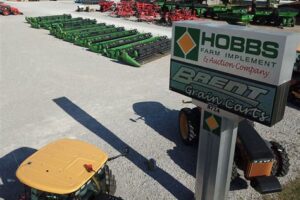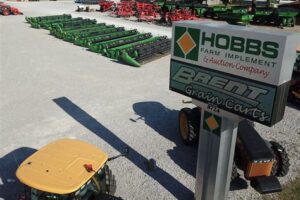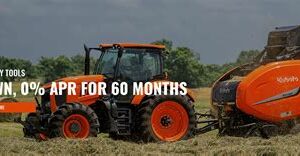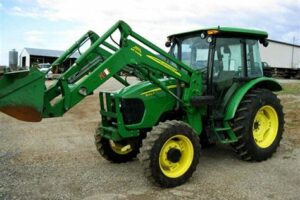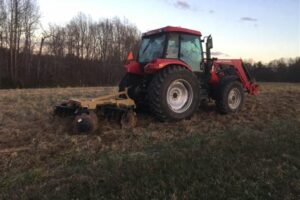Table of Contents
Depreciation life for farm equipment refers to the estimated period over which a farmer can deduct the cost of purchasing or improving machinery and equipment used for agricultural purposes. Understanding depreciation life helps farmers determine the tax benefits and plan their equipment investments accordingly.
When it comes to farming, having reliable and efficient equipment is crucial for success. However, the cost of purchasing and maintaining farm equipment can be a significant investment for farmers. One important factor to consider is the depreciation life of the equipment, which determines how long the equipment will be useful and retain its value. Understanding the concept of depreciation life is essential for farmers to make informed decisions about their equipment purchases and plan for future replacements. In this article, we will delve into the concept of depreciation life for farm equipment and explore its impact on farming operations.
The Importance of Depreciation Life for Farm Equipment
As a farmer, it is crucial to understand the concept of depreciation life for farm equipment. Depreciation refers to the decrease in value of an asset over time due to wear and tear, obsolescence, or other factors. For farm equipment, which is often subject to heavy use and harsh environmental conditions, depreciation can have a significant impact on the financial health of your operation. In this article, we will explore the importance of understanding and managing the depreciation life of your farm equipment.
What is Depreciation Life?
Depreciation life refers to the estimated period over which an asset, such as farm equipment, is expected to be used before its value is fully depreciated. It is commonly expressed in terms of years. Understanding the depreciation life of your farm equipment is essential for several reasons. Firstly, it helps you plan for replacement or upgrades in the future. Secondly, it enables you to accurately calculate the true cost of owning and operating your machinery. Finally, it allows you to make informed decisions about purchasing new or used equipment.
Factors Affecting Depreciation Life
Several factors can influence the depreciation life of your farm equipment. One of the primary factors is the type of equipment. Different pieces of machinery have varying levels of durability and expected lifespans. Additionally, the frequency and intensity of use, as well as the maintenance practices employed, can impact the depreciation rate. Lastly, technological advancements and changes in industry standards can render certain equipment obsolete more quickly than others.
Importance of Regular Maintenance
In order to maximize the depreciation life of your farm equipment, regular maintenance is crucial. Proper maintenance practices can help prevent premature wear and tear, minimizing the depreciation rate. This includes routine inspections, cleaning, lubrication, and timely repairs. By adhering to a strict maintenance schedule and addressing any issues promptly, you can extend the lifespan of your equipment and maintain its value for longer.
Tracking Depreciation for Financial Planning
Accurately tracking the depreciation of your farm equipment is essential for effective financial planning. By understanding the expected depreciation rate, you can incorporate it into your budgeting and forecasting processes. This will enable you to anticipate future replacement costs and allocate resources accordingly. It also allows you to make informed decisions about whether it is more cost-effective to repair or replace a piece of equipment when the time comes.
Weighing the Cost: New vs Used Equipment
Understanding the depreciation life of farm equipment is particularly important when deciding between purchasing new or used machinery. New equipment may have a longer depreciation life but comes with a higher upfront cost. On the other hand, used equipment may have a shorter depreciation life but can be more affordable initially. By evaluating the depreciation rates and projected lifespans of both options, you can make an informed decision that aligns with your budget and operational needs.
Resale Value Considerations
Another crucial aspect of depreciation life for farm equipment is its impact on resale value. When the time comes to sell or trade-in your machinery, understanding its depreciation life can help you determine a fair asking price. Equipment that has depreciated less will generally have a higher resale value. Additionally, proper maintenance and documentation of service history can also positively influence the perceived value of your equipment, enhancing its marketability.
Planning for Equipment Replacement
By understanding the depreciation life of your farm equipment, you can proactively plan for its replacement. It’s important to consider factors such as the estimated remaining useful life, expected costs of new equipment, and any technological advancements that may improve efficiency or productivity. By factoring in these variables, you can create a strategic equipment replacement plan that minimizes downtime and maximizes the return on investment.
Consulting Experts and Industry Resources
For accurate and up-to-date information on depreciation life and other equipment-related matters, it can be beneficial to consult experts in the field or utilize industry resources. Farm equipment manufacturers, industry associations, and agricultural consultants often provide valuable insights and guidance on topics such as equipment lifespan, maintenance best practices, and projected depreciation rates. Staying informed and seeking professional advice can help you make well-informed decisions regarding your farm equipment investments.
Integrating Depreciation Life into Financial Management
Lastly, understanding and effectively managing the depreciation life of your farm equipment is essential for sound financial management. By incorporating depreciation expenses into your financial statements and budgeting processes, you can accurately assess the profitability of your operation. This enables you to make informed decisions regarding equipment investments, cash flow management, and overall financial planning.
In conclusion, depreciation life for farm equipment plays a vital role in the financial health and operational efficiency of any farming operation. By understanding the factors influencing depreciation, practicing regular maintenance, tracking depreciation for financial planning, considering the cost and resale value of equipment, planning for replacement, and seeking expert advice, farmers can optimize their equipment investments and ensure long-term success.
Introduction to Depreciation Life for Farm Equipment
Depreciation life refers to the estimated duration over which a farm equipment’s value declines due to wear and tear, obsolescence, or aging. It is a crucial factor for farmers and agricultural businesses as it determines the tax deductions they can claim for their equipment. Understanding the depreciation life for farm equipment is essential for making informed financial decisions and optimizing the farm’s profitability.
Factors Influencing Depreciation Life
Several factors influence the depreciation life of farm equipment, including the type and quality of the equipment, intensity of its use, maintenance practices, technological advancements, and market demand. Higher-quality and well-maintained farm equipment tends to have a longer depreciation life compared to lower-quality or poorly maintained equipment. Additionally, advancements in technology can render certain equipment obsolete sooner, reducing their depreciation life.
Calculating Depreciation Life
Calculating the depreciation life for farm equipment involves considering various methods, such as the straight-line method, declining balance method, or accelerated cost recovery system. These methods help determine the annual depreciation expense, which is then used to estimate the number of years it would take for the equipment’s value to depreciate fully. Farmers may consult with accounting professionals or utilize software programs specifically designed for calculating depreciation.
Importance of Accurate Depreciation Life Estimations
Accurate depreciation life estimations are crucial for financial planning, tax management, and replacement decision-making for farm equipment. By correctly estimating depreciation, farmers can appropriately allocate funds for equipment replacement or repairs, maintain an accurate balance sheet, and maximize tax deductions. Incorrect estimations may result in financial losses, tax penalties, or an improper assessment of the farm’s profitability.
Impact of Depreciation Life on Equipment Replacement
Understanding the depreciation life of farm equipment is essential when determining the optimal time for replacement. It allows farmers to assess the equipment’s remaining useful life, anticipated repair costs, and potential resale value. By timely replacing depreciated equipment, farmers can avoid unexpected breakdowns, enhance operational efficiency, and reduce long-term maintenance expenses.
Maintaining Equipment to Extend Depreciation Life
Regular maintenance and proper care play a significant role in extending the depreciation life of farm equipment. Adhering to manufacturer guidelines, conducting routine inspections, servicing equipment, and promptly addressing any repairs or issues can effectively prolong the usefulness of the equipment. Regular maintenance not only reduces the depreciation rate but also helps maintain its resale value.
Evaluating Technological Advances and Market Conditions
Technological advancements and changes in market conditions can significantly impact the depreciation life of farm equipment. As new technologies emerge, older equipment may become obsolete more quickly, reducing its depreciation life. Farmers should stay up-to-date with industry trends, market demands, and emerging technologies to make informed decisions regarding the depreciation life of their equipment.
Consulting Professionals for Depreciation Life Assessments
Given the complexities involved in determining the depreciation life for farm equipment, it is advisable for farmers to consult accounting professionals or tax advisors. These professionals possess the expertise and knowledge to navigate through tax regulations, evaluate equipment valuation methods, and provide accurate estimations. Seeking professional advice ensures compliance with tax laws, optimal financial planning, and proper management of farm equipment depreciation.
Depreciation life for farm equipment is a crucial aspect that every farmer needs to consider when managing their agricultural operations. As farm equipment plays a vital role in enhancing productivity and efficiency, understanding its depreciation life is essential for financial planning and decision-making.
Here are some key points of view regarding the depreciation life for farm equipment:
- Depreciation as a Cost: Farmers should view depreciation as a cost that needs to be allocated over the useful life of the equipment. Just like any other business, accounting for depreciation allows farmers to accurately reflect the wear and tear of their machinery over time.
- Impact on Financial Statements: Depreciation affects the financial statements of a farm operation. By depreciating farm equipment, farmers can accurately track the value of their assets and determine the true cost of production. It helps in providing accurate financial information for lenders, investors, and stakeholders.
- Useful Life Determination: Determining the useful life of farm equipment requires a comprehensive assessment of various factors such as technological advancements, maintenance practices, and expected usage. It is crucial to evaluate the specific conditions under which the equipment operates to make an informed decision about its depreciation life.
- Maintenance and Repair Costs: The depreciation life of farm equipment directly impacts maintenance and repair costs. As equipment ages, the likelihood of breakdowns and repairs increases. By considering the depreciation life, farmers can estimate the potential maintenance and repair expenses, allowing them to budget accordingly.
- Resale Value: Understanding depreciation life is essential when considering the resale value of farm equipment. Equipment that has exceeded its useful life may have limited resale value, whereas properly maintained and younger machinery could retain a higher value. Farmers need to account for depreciation when determining the potential return on investment from selling their equipment.
- Technology Upgrades: Farming equipment is constantly evolving, with new technologies offering improved efficiency and productivity. Considering depreciation life allows farmers to plan for equipment upgrades, ensuring they stay competitive in the industry. Understanding the depreciation of existing equipment helps in making informed decisions about investing in newer and more advanced machinery.
In conclusion, depreciation life for farm equipment is a critical aspect that farmers should consider. It not only helps in accurate financial reporting but also influences maintenance costs, resale value, and decision-making regarding equipment upgrades. By understanding and accounting for depreciation, farmers can effectively manage their agricultural operations and make informed financial decisions.
Thank you for visiting our blog and taking the time to read our article on Depreciation Life for Farm Equipment. We hope that you have found the information provided to be informative and helpful in understanding the importance of depreciation in the context of farm equipment. As professionals in the industry, we believe it is crucial for farmers and agricultural businesses to have a clear understanding of how depreciation impacts their bottom line.
Depreciation is a term often heard in financial discussions, but its significance in the agricultural sector cannot be overstated. It refers to the reduction in value of an asset over time, and farm equipment is no exception. As a farmer, it is essential to have a comprehensive understanding of depreciation life for your machinery, as it directly affects your financial planning and decision-making processes.
Understanding the depreciation life for farm equipment allows you to make informed choices when it comes to purchasing and replacing machinery. By factoring in the expected lifespan of your equipment, you can accurately estimate the annual depreciation expense and incorporate it into your budget. This practice ensures that you are setting aside sufficient funds for future equipment replacements and avoiding sudden financial burdens.
In conclusion, depreciation life for farm equipment is a crucial aspect of financial management in the agricultural industry. It allows farmers to plan for the eventual replacement of their machinery and ensures that they are financially prepared for such expenses. By incorporating depreciation into your budgeting process, you can make informed decisions about equipment purchases and replacements, ultimately contributing to the long-term sustainability and success of your farming operations.
We hope that this article has provided you with valuable insights into the concept of depreciation life for farm equipment. Should you have any further questions or require additional information, please do not hesitate to reach out to us. Thank you again for visiting our blog, and we look forward to sharing more informative content with you in the future!
Video Depreciation Life For Farm Equipment
People also ask about Depreciation Life for Farm Equipment:
-
What is the depreciation life for farm equipment?
The depreciation life for farm equipment refers to the number of years over which the equipment’s value is reduced or depreciated for accounting and tax purposes. The specific depreciation life can vary depending on the type of equipment and its intended use.
-
How is the depreciation life determined for farm equipment?
The depreciation life for farm equipment is typically determined by the Internal Revenue Service (IRS) or other relevant tax authorities. These agencies provide guidelines and tables that assign specific depreciation periods for different types of equipment. Factors such as the expected useful life, technological advancements, and industry standards are taken into account when determining the depreciation life.
-
Why is knowing the depreciation life important for farm equipment owners?
Knowing the depreciation life is important for farm equipment owners as it allows them to accurately reflect the decrease in value over time in their financial statements and tax returns. It helps in spreading out the cost of the equipment over its useful life, resulting in fairer taxation and improved financial planning.
-
Can the depreciation life for farm equipment be adjusted?
In some cases, the depreciation life for farm equipment can be adjusted based on specific circumstances. For example, if a piece of equipment is used more intensively or experiences higher wear and tear due to harsh operating conditions, the owner may be able to justify a shorter depreciation life. However, any adjustments should comply with the regulations set by tax authorities.
-
What happens after the depreciation life ends for farm equipment?
After the depreciation life ends for farm equipment, the equipment is considered to have no remaining value for tax purposes. However, this does not necessarily mean that the equipment is no longer usable or valuable. It simply means that the equipment has been fully depreciated according to tax regulations.

